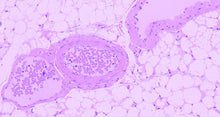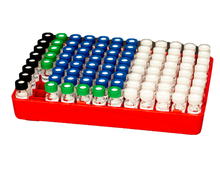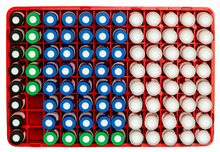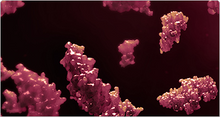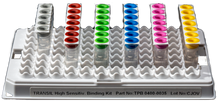
Compounds binding strongly to plasma proteins frequently result in overly small compound concentrations that are difficult to measure accurately. Also, time to equilibrium increases the stronger compounds bind to plasma. The TRANSIL High sensitivity binding kit solves this by introducing another binding matrix and analyzing the binding equilibrium between this solid-phase matrix (natural membranes) and the liquid phase including plasma.
Highly lipophilic and sticky compounds also create notorious difficulties in plasma protein binding assays. The TRANSIL High sensitivity binding kit addresses this by providing plasma in all assay compartments.
Thus, the TRANSIL High Sensitivity Binding Kit accurately determines the unbound fraction of drugs that are tightly bound to plasma proteins - even when the unbound fraction is well below 1%. Also, the TRANSIL assay yields high recovery for drugs that exhibit too high unspecific binding in other assay systems, or precipitate because of low solubility. The kit determines the fraction of drug bound to plasma indirectly by measuring the partitioning of drug between the plasma proteins and artificial cell membranes.
Internal quality controls provide easy assessment of recovery, experiment and data quality.
The kit consists of silanized glass vials pre-filled with buffer and membrane beads.
The assay requires only 6 steps: (i) addition of plasma, (ii) addition of drug candidate, (iii) incubation for 30 minutes while mixing, (iv) removal of beads by centrifugation, (v) precipitation of plasma, and (vi) quantification of compounds.
 Figure 1: Comparison of fraction unbound measurements obtained via dialysis and the TRANSIL High Sensitivity Binding kit. Marketed drugs having average physchem properties yield comparable results in both assays.
Figure 1: Comparison of fraction unbound measurements obtained via dialysis and the TRANSIL High Sensitivity Binding kit. Marketed drugs having average physchem properties yield comparable results in both assays.  Figure 2: Comparison of fraction unbound measurements obtained via erythrocyte partitioning and the TRANSIL High Sensitivity Binding kit. Early discovery compounds binding strongly to plasma proteins yield comparable results in both assays.
Figure 2: Comparison of fraction unbound measurements obtained via erythrocyte partitioning and the TRANSIL High Sensitivity Binding kit. Early discovery compounds binding strongly to plasma proteins yield comparable results in both assays.  Figure 3: Comparison of fraction unbound measurements at 4, 6, and 24 hours incubation in dialysis versus 30 minutes incubation in the TRANSIL High Sensitivity Binding kit (dotted line). The compound is a lipophilic acid with a cLogP of 6.1 and a molecular weight of 503. Fraction unbound estimates from the longer incubation times of dialysis converge towards the result of the TRANSIL assay.
Figure 3: Comparison of fraction unbound measurements at 4, 6, and 24 hours incubation in dialysis versus 30 minutes incubation in the TRANSIL High Sensitivity Binding kit (dotted line). The compound is a lipophilic acid with a cLogP of 6.1 and a molecular weight of 503. Fraction unbound estimates from the longer incubation times of dialysis converge towards the result of the TRANSIL assay.  Figure 4: Reproducibility of the TRANSIL High Sensitivity Binding kit showing results from 5 independent fraction unbound measurements of diclofenac.
Figure 4: Reproducibility of the TRANSIL High Sensitivity Binding kit showing results from 5 independent fraction unbound measurements of diclofenac.Key Benefits:
Determine PPB of drugs with fu<1%
- Tightly bound fu<0.01% or less
- Highly sticky
- Poorly soluble
- Lipophilic
Versatile assay
- Can be used with any plasma
- Human
- Dog
- Monkey
- Rat
- Mouse
Fast and easy to use assay kit
- No preparation required
- Build-in quality control
- Suitable for high throughput screening
- Ready-to-use data analysis spreadsheet





